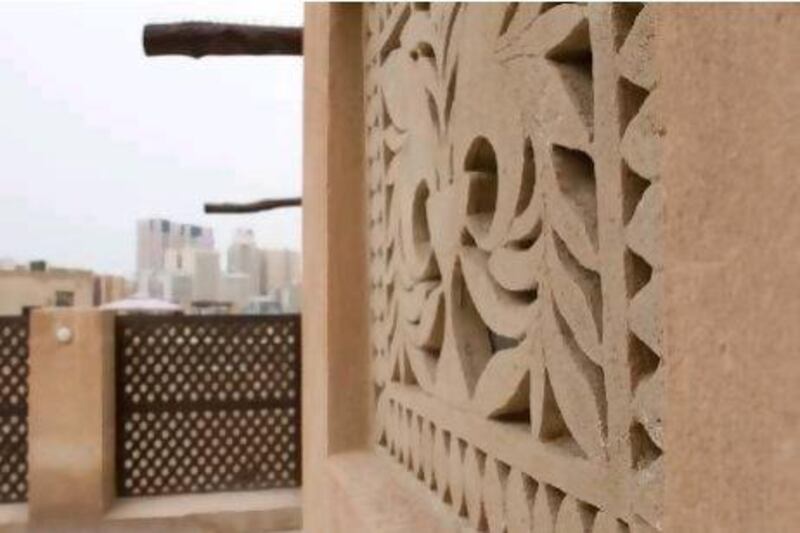DUBAI // The intricate flowing designs are familiar to anyone who has walked the historic streets of Al Bastakiya and marvelled at its walls of gypsum, dried coral, limestone and sand.
But far less familiar is the painstaking work that goes into making them.
Huda Mohammed, an Emirati, was one of many who found out just how tricky the traditional Emirati craft is at one of the many gypsum-carving workshops being held as part of this week's Dubai Heritage Festival.
"We have this design above our windows in our traditional homes," said Ms Mohammed, 24, as she dug into a square-shaped piece of rock with a carving knife at Etihad Mall. "But I never knew it took so much effort for it to be created."
The workshops offer visitors two options in making their own, personalised slabs of gypsum. In the first, chosen by Ms Mohammed, the workshop artisans draw designs on to a slab of gypsum and the participant tries to carve along the lines of the design.
For those less sure of their carving skills, the artisans use red rubber moulds to produce slabs with ready-made floral designs, some with Arabic calligraphy, and these can then be personalised by painting.
The workshops are being held daily until Saturday.
Similar activities and other heritage-themed events are taking place throughout the week in Al Bastakiya, the Dubai and Ibn Battuta malls, Dubai Municipality in Deira, Dubai Public Library, Hatta National Arts and Cultural Association and Dubai International Airport.
The white-grey slabs of gypsum, or sulphate carbonate, are part of the Gulf's history and can found in almost every historic home and building across the UAE.
"You see this gypsum? We got it from Jebel Ali mountain," said the Emirati architect Rashad Bukhash as he held up one particularly chunky stone. Its shades of yellow and grey tinged with crystal gave it an appearance similar to quartz.
Mr Bukhash is the director of the Architectural Heritage Department at Dubai Municipality, which is organising the festival with Dubai Culture and Arts Authority and other partners.
To make the gypsum ready for use, slabs are piled up around the outside of a circular oven before being heated for three days.
"This technique allows for 75 per cent of the water in the stone to evaporate, making it softer before it is crushed into powder to be used as mortar or cement in construction of buildings and homes," said Mr Bukhash.
"You then add water and sometimes limestone for strength, and have about an hour before it hardens, within which time you can do what you want with the gypsum.
"This material and technique should not be forgotten as it is a core element of all our traditional and heritage buildings."
Because humidity can wear the gypsum down, traditional homes need maintenance every three to four years.
Mr Bukhash is also a member of the FNC, having won a seat for Dubai in last September's election.
When he is not working on council matters, he spends his time on restoration projects and lecturing at architecture festivals.
"It is my passion. I work with every bit of a building," he said. "I like the feel of this gypsum and every raw material used in a historical structure."
Over the past two decades, Mr Bukhash has renovated at least 150 historic sites and buildings in Dubai.
But the heritage week involves more than members of the public leaving their fingerprints on traditional building blocks.
A Heritage Footprint initiative will ask Emiratis to sign a pledge to speak Arabic, wear traditional dress and visit heritage sites, among other promises, in an effort to protect national identity.
Mr Bukhash said the pledge would be circulated on social media such as Twitter and Facebook in an effort to get 50,000 Emiratis to sign up. He said the effort was aimed particularly at the nation's youth, but was unwilling to divulge more ahead of today's launch.
In collaboration with the Ministry of Education, the Dubai Culture and Arts Authority will host a range of activities at Al Hudaibiah Primary School for nursery pupils, Al Kuwait Primary School and the Sakina bint Al Hussain School for secondary students.
The theme of the activities is Dubai: Live our Heritage.
"This year we are focused on promoting heritage week through a range of educational activities, which are mainly aimed at instilling the customs of our region in our youth from an early age," said Salem Belyouha, the authority's projects and events director.
"Understanding one's past is important, as it serves as a reservoir of strength into future growth and development."
Next month, the former house of the Emirati poet Mubarak Al Oqaili will open as a museum in Deira. All of his possessions, including his pens, books and carpets, will be on display to the public as a celebration of his life and work.
And a heritage train will chug through Dubai Creek Park tomorrow, carrying 60 passengers at a time. The park is located between the Garhoud and Maktoum bridges.
* For detailed information on the Heritage Week activities, call 04 800 4003.






